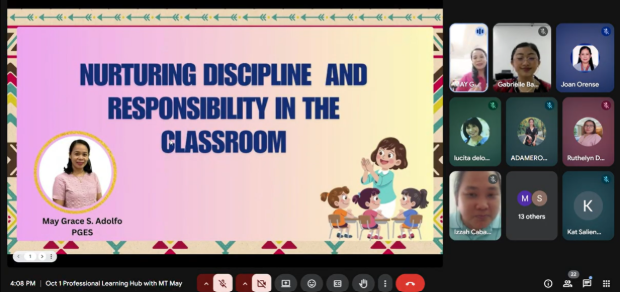


by Sieralyn Moya
“Practice what you preach, practice what you teach.”
These words set the tone for an insightful online session on Nurturing Discipline and Responsibility in the Classroom, led by Teacher May Grace S. Adolfo, Master Teacher I from Pedro Guevara Elementary School (PGES), on October 1, 2025, from 4:00 to 5:00 PM held via Google Meet and attended by twenty nine BINHI teachers. The statement reminds us that as teachers, our actions carry as much weight as our words, students learn not only from what we say but from how consistently we model discipline and responsibility ourselves.
Why Discipline and Responsibility Matters Today
In today’s rapidly changing educational landscape, teachers face the challenge of managing diverse classrooms where students bring different backgrounds, needs, and behaviors. While academic achievement is a key goal, it cannot be attained without first cultivating discipline and responsibility. Teacher May emphasized that these qualities form the backbone of effective learning environments, ensuring that students remain engaged, respectful, and ready to take ownership of their actions and decisions.
Yet, maintaining discipline is not about imposing rigid control; it is about establishing routines, expectations, and consistency that empower students to develop self-control and accountability. As Teacher May mentioned during the learning hub session, discipline and responsibility are habits formed over time, and they thrive under guidance that is steady, clear, and compassionate.
Practical Insights from the Classroom
Drawing from her own experiences in teaching Grade 1, Teacher May shared how simple but consistent classroom routines can make a significant difference in shaping young learners’ behavior. From entering the classroom calmly, to responding to verbal and non-verbal cues, these routines become anchors that students learn to follow naturally.
For example, she explained how non-verbal cues, such as hand signals or specific gestures, help maintain order without interrupting the flow of lessons. Over time, students not only respond to these cues but also begin to internalize the values of attentiveness, respect, and cooperation.
One of the most important takeaways was the power of consistency. Whether in praise, reminders, or routines, a teacher’s steadfastness builds trust and predictability. When students understand what is expected of them every day, they feel more secure and are more likely to practice responsibility on their own.
Real-Life Application
One case shared by Teacher May illustrated how routines transformed her Grade 1 class. To effectively manage young learners, Teacher May demonstrated a non-verbal finger signal system that reinforces discipline and focus during class activities:
Another effective classroom routine shared by Teacher May involves collecting materials efficiently and harmoniously. When it is time to pass papers or notebooks, students sing together with her, “Mula sa likod, papunta sa harap,” as they pass their work forward. A designated class leader then gathers the collected materials and hands them to Teacher May, ensuring order and preventing unnecessary movement around the classroom. This joyful, structured activity teaches teamwork, cooperation, and responsibility while maintaining discipline and minimizing distractions.
Through patient repetition of structured routines and consistent cues, she was able to redirect this energy into smooth, orderly transitions. The result was not just a quieter classroom, but a learning space where students knew what to do, when to do it, and why it mattered. This shows that discipline in the classroom is not about strict enforcement, it is about creating an environment where students can thrive because expectations are clear, fair, and consistently reinforced.
Takeaways and Reflection
The seminar was not only an opportunity to learn from Teacher May but also a venue for BINHI teachers to share their own classroom best practices. Teacher Frances Sunga from Juan Sumulong Elementary School (JSES) shared how she fosters empathy and inclusivity among her students by addressing learners with special needs as “baby” and encouraging the rest of the class to behave properly and assist “baby” inside the classroom. This simple yet heartfelt approach builds a caring classroom environment where discipline is rooted in kindness and mutual respect.
The session concluded with a renewed appreciation for the vital role teachers play in shaping not only the minds but also the character of their students. Through consistency, empathy, and meaningful routines, educators can cultivate classrooms where discipline and responsibility flourish naturally. As the BINHI teachers reflected on Teacher May’s words—“Practice what you preach, practice what you teach”—they were reminded that the most effective lessons are not spoken, but lived every day within the classroom walls.